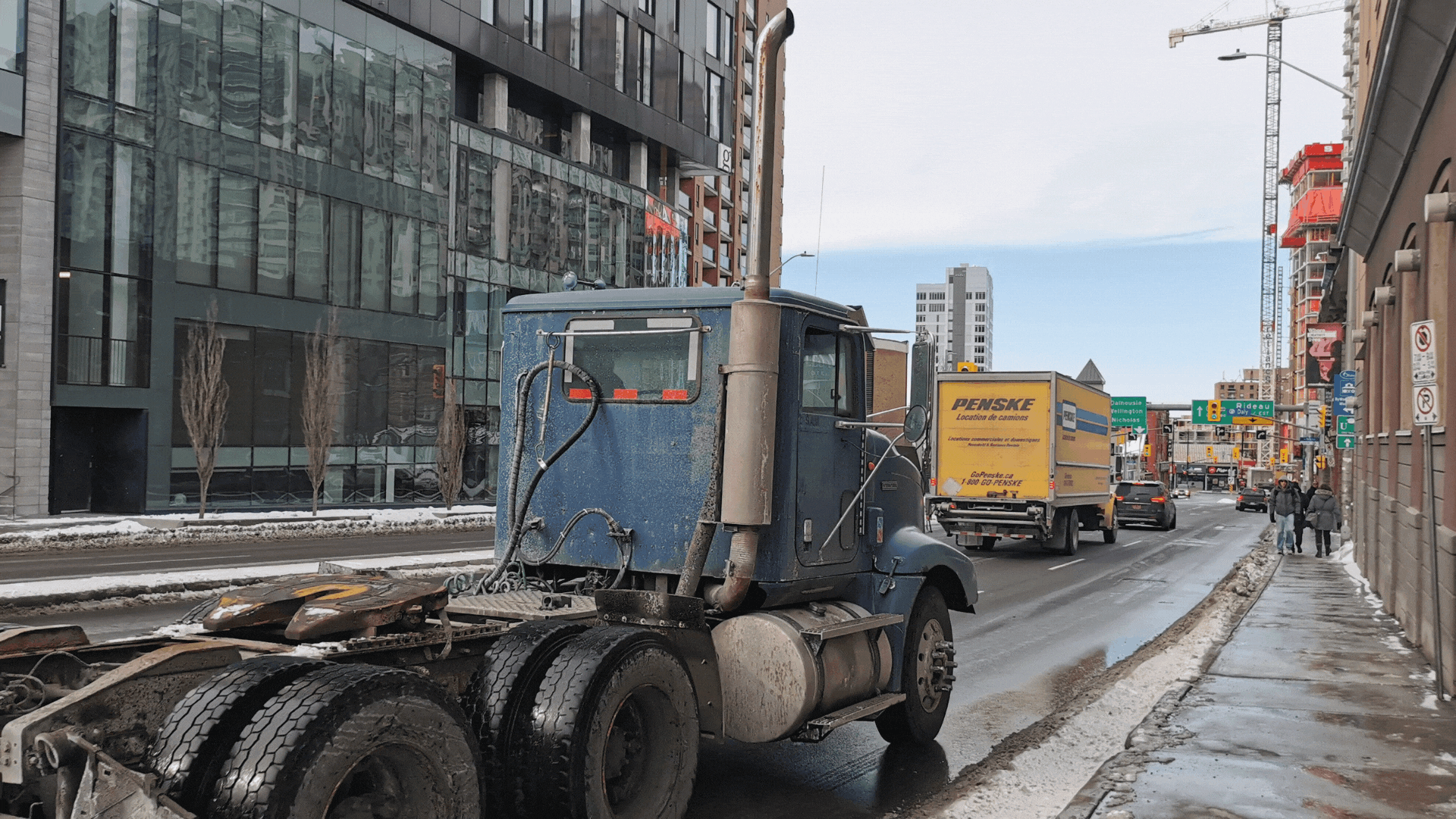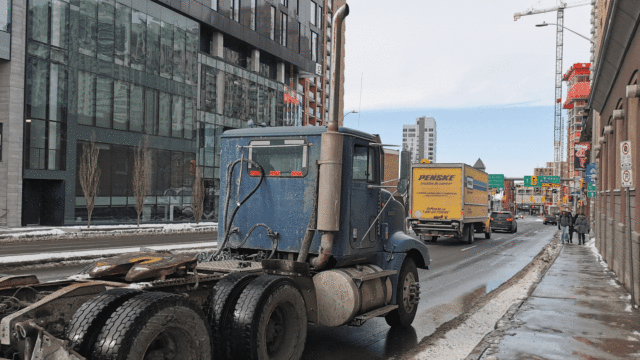By: John Verbaas (Action Sandy Hill) and Dominic Santos (Lowertown Community Association)
June 5 marks Clean Air Day in Canada, a day to recognize the importance of good air quality to our health, environment, and the economy. But for those who live and work with elevated levels of air pollution along Ottawa’s downtown interprovincial trucking route, the day rings a bit empty.
The City of Ottawa’s traffic by-law directs heavy, interprovincial truck traffic through Lowertown and Sandy Hill, some of the most densely populated areas of downtown Ottawa. This poses serious health and safety risks to those who live and work in these communities. The issue stems from a lack of proper infrastructure to connect Highway 417 in Ottawa and Highways 5/50 in Gatineau.
This truck route is a significant contributor to the increasing potpourri of conditions that has led to serious urban decay in this historic area of Ottawa’s downtown. The route is one of the most egregious examples of truck routings through urban neighbourhoods in Canada. What is happening In Ottawa is an outlier and it should be ‘on the radar’ as one of the larger unresolved transportation issues in the country.
Trucking route poses serious health and safety concerns
Globally, air pollution is recognized as a major health risk. In Ontario alone, it is estimated that air pollution causes approximately 6,700 premature deaths every year. Diesel emissions from heavy trucks, like the ones driven along the downtown trucking corridor, are considered the most hazardous pollution of vehicle emissions, posing serious risks to those within 50-250 metres of the roadway. This is especially dangerous for folks in our community with existing health issues, especially respiratory conditions.
Air quality monitoring conducted by Ecology Ottawa in 2023, and released today in their updated Breathe Easy Report, shows elevated air pollution along the trucking corridor. The Sandy Hill neighbourhood experienced the highest air pollution in Ottawa.
On top of the pollution concerns, the trucks endanger the safety of pedestrians and cyclists. Thousands of tractor trailer sized trucks wind their way every day through urban neighbourhoods making tight turns at several intersections that also carry thousands of pedestrians each day. The trucking route cuts the community of Lowertown in half; residents have expressed a feeling of isolation because of their unease in crossing King Edward Avenue.
Trucks have caused several deaths of pedestrians. Cycling traffic along these streets is virtually nonexistent as they are extremely unsafe for cycling. Noise from these trucks accelerating and decelerating between intersections is unacceptable for a dense, urban neighbourhood.
Groups request human rights investigation
A group of health, community, and environmental organizations are calling on the Ontario Human Rights Commission (OHRC) to launch a human rights investigation into the route. The request was submitted last month by Ecojustice, Canadian Association of Physicians for the Environment, Friends of the Earth Canada, Action Sandy Hill, and the Lowertown Community Association.
The move is part of ongoing efforts to address the urgent health threat posed by heavy truck emissions along the route and comes more than a year after an open letter to Ottawa Mayor Mark Sutcliffe, which has to date gone unanswered.
It is our hope that an inquiry by the Ontario Human Rights Commission will shed light on the disproportionate and discriminatory impacts of heavy truck air pollution on residents along the trucking corridor, including people with disabilities, children, elderly individuals, unhoused individuals, and people living in poverty. The community should be consulted and involved in proposing solutions.
It’s time for accountability and action from our elected representatives
Due to the overlapping jurisdictional nature of the trucking route, it is too easy for politicians at all levels of government to consider that this is someone else’s problem to solve. The affected communities of Lowertown and Sandy Hill are looking for elected officials who will prioritize this problem and take the leadership required to propose a viable solution.
A solution to this problem requires the will and resources of the provincial government whose mandate is to provide an interconnected system of highways. The Ford government recently announced an agreement partnering with the municipal government in Ottawa to solve “the unique challenges that Ottawa faces.” The downtown truck route problem was completely missing from this conversation.
Meanwhile, the mayor of Ottawa doesn’t appear to have this issue on his agenda either. Since coming to power in Ottawa, our affected communities have yet to benefit from any engagement from the mayor’s office on this issue of interprovincial through trucks in the downtown. The truck route traverses through very socioeconomically diverse areas, with many residents that can’t be particularly politically active. This reality has contributed to the lack of engagement between the City and frontline communities along the route.
Our communities need real solutions now
Over the past 30 years, several attempts to address the trucking route have been tried and failed. Additional potential initiatives have been proposed by health and environmental groups, including establishing an ultra-low emissions zone, continuous air quality monitoring, and a comprehensive program to improve air quality in the downtown core. More options have been proposed in the request submitted to OHRC.
Our communities, like any other, have a right to enjoy clean, safe communities and air. We need some bold new leadership who will propose fresh ideas which will lead to a real solution to the Ottawa downtown truck problem.


